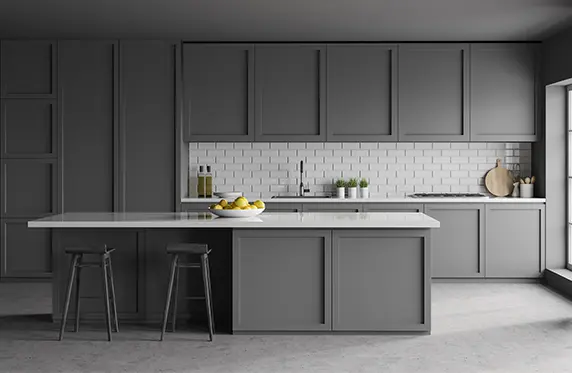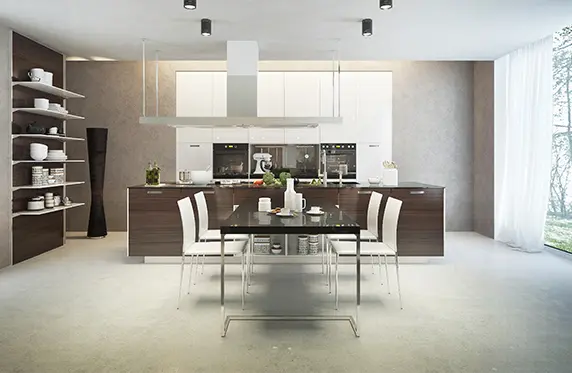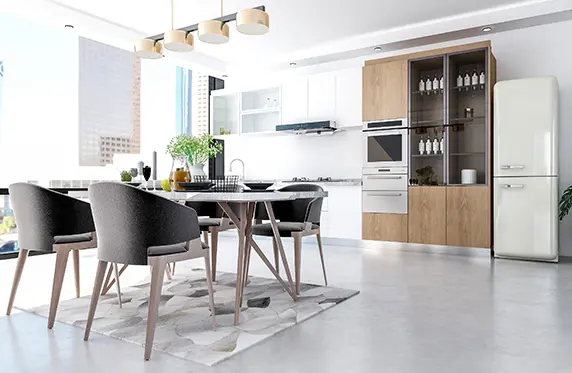Micro-cement in kitchens
The kitchen is one of the parts of the house that undergoes the most wear over the years. We spend a lot of time in it and a bacteria-free and practical coating is necessary. Applying microcement in the kitchen is the ideal solution to have a clean space, without joints and with modern finishes.
This continuous decorative coating transforms the kitchen into an environment full of inspiration where design, aesthetics, and elegant finishes come together. The feeling of luminosity and spaciousness becomes the best incentive to enjoy a room in which many moments to remember are lived.
The rooms of the house tend towards versatility and open spaces. The kitchen is no exception and micro-cement is the best ally to enhance this part of the home without superfluous elements.
Advantages of micro-cement in kitchens
Micro-cement has become one of the most popular options to cover kitchens. And that is that this material offers a series of advantages that make it ideal for a room so exposed to wear and humidity. Here are the main benefits of applying micro-cement in kitchens:

Resistance and durability
One of the main advantages of micro-cement is its high resistance and durability. This material is capable of withstanding constant traffic, stains, and daily kitchen use. Moreover, its ability to adhere to different surfaces makes it a versatile option to renovate or cover any type of structure, including walls, floors, countertops, or kitchen tables.
Hygiene and easy cleaning
Microcemento is a material that does not have pores or joints, which prevents the accumulation of bacteria and dirt. Therefore, it is a very hygienic material and easy to clean. It is enough to use a mild detergent and water to keep the microcement in perfect condition.
Waterproof
Another advantage of microcemento is its waterproof quality. This makes it ideal for use in the kitchen, where there is a high level of humidity and a coating that is resistant to water is required. Microcement does not absorb moisture, which prevents the appearance of mold and the proliferation of bacteria.
Slipe-resistant
Microcemento can be treated with products that make it slip-resistant, making it a safe option for use on kitchen floors. This is especially important in kitchens where oil or water is cooked, as they can fall to the floor and cause slips.
Tolerance to high temperatures
Microcemento is a material that holds up very well to high temperatures. It is resistant to the heat generated by stoves and cooktops, making it ideal for use as a wall covering and countertops. In addition, its tolerance to high temperatures also makes it resistant to moisture and steam.
Aesthetics and design
Microcement is a very versatile material in terms of aesthetics and design. Thanks to its continuity, as well as its ability to trap light and generate optical sensations of amplitude and luminosity, microcement can make a small kitchen seem larger and brighter. Furthermore, there is a wide variety of colors, finishes, and textures available, allowing for the creation of personalized designs tailored to the needs of each project.
Microcement in kitchens: a safe choice
Microcement in kitchens is a choice for a material that has seduced interior designers and architects. The variety of finishes and the ease of working with this material make it ideal for customizing the kitchen according to the needs of each project. However, its aesthetic contribution goes much further.
So, what is the aesthetic value of smoothed microcement in this part of the house? Smoothed microcement brings a sense of continuity and softness to the kitchen surfaces, conveying sophistication and harmony to the environment.
Moreover, being such a versatile material, it is possible to combine it with other materials such as wood or stainless steel, to achieve a flexible and customized design that adapts to each style and taste.
Another aesthetic advantage of microcement in the kitchen is its ability to capture light and generate optical sensations of spaciousness and brightness. This is especially important in a space like the kitchen, where lighting is fundamental for comfortable work and for enjoying the environment.
In addition to its beauty and versatility, microcement is a resistant and durable material, capable of withstanding moisture and daily wear in the kitchen. Its waterproof and slip-resistant quality make it ideal for coating walls, floors and countertops, without worrying about stains or premature wear.
Line, decorate, renew and transform the kitchen fleeing from extreme shapes and colors. It is a sober product to create elegant, immaculate environments with a craft execution.

Microcement in the kitchen: choose the most suitable finish
The kitchen is one of the most important rooms in a home, as it is the place where food is prepared and moments are shared with family and friends. For this and many other reasons, it is essential to carefully choose the materials that will be used in its decoration and design.
Microcement is a very versatile material that has gained much popularity in recent years, but it is important to note that not all finishes are suitable for use in kitchens. That is why it is crucial to know the different types of finishes and to select the one that best suits our needs and lifestyle, hence ensuring its durability and resistance in the long term.
Matte microcement kitchen
The matte finish of microcement is ideal for those who are looking for a subtle and discreet surface in their kitchen. This finish is characterized by being opaque and not reflecting light, which gives it a more natural and rustic look. In addition, the matte finish is very resistant to abrasion and stains, making it perfect for the kitchen.
However, one of the disadvantages of the matte finish is that it may be more difficult to clean than other finishes due to its porous texture.
Satin microcement kitchen
The satin finish of the microcement is a very popular option in kitchen decoration. This finish has a soft shine that reflects light, giving it a more elegant and sophisticated look. The satin finish is also very resistant to stains and abrasion, making it very practical for the kitchen.
One of the advantages of the satin finish is that it is easier to clean than the matte finish due to its smoother and less porous texture. In addition, by reflecting light, the satin finish can make the kitchen look bigger and brighter.
Glossy microcement kitchen
The glossy finish of the microcement is the most striking of the three finishes, as it has a high shine that reflects light. This finish is perfect for smaller kitchens that need to play with light to create the visual effect of spaciousness and brightness. The glossy finish is also very resistant to stains and abrasion, making it very practical for the kitchen.
However, the glossy finish also has some disadvantages. It is harder to clean than other finishes due to its shine and texture, making dirt and marks more noticeable. In addition, the glossy finish can make the kitchen appear smaller and more oppressive if used over large surfaces.
In conclusion, microcement is a very versatile material that can be used in any room in the house, including the kitchen. The different finishes available allow you to select the one that best fits the needs of the room and the decoration style.
Microcement in kitchens: areas of application
The kitchen is one of the spaces in the house where we spend the most time and, therefore, it is important that its design is both functional and aesthetic. In this sense, microcement has become an excellent option to coat and decorate the different areas of the kitchen. The variety of finishes and textures offered by this material allows us to create customized and unique environments, adapted to the needs and tastes of each project.
Microcement in the kitchen: application on walls
On the kitchen wall, microcement is an ideal option to create an elegant, sophisticated and timeless environment. Thanks to its high resistance and durability, this coating is able to withstand the humidity, heat, and impacts typical of the kitchen, without losing its aesthetic qualities. Furthermore, microcement can be applied to any surface, which makes it an ideal solution to renovate the kitchen without having to carry out major works.
Microcement in the kitchen: application on the floor
Regarding the kitchen floor, microcement is a very versatile option that offers multiple advantages. On one hand, the absence of joints and the continuity of the surface provides a feeling of spaciousness and brightness very pleasing to the eye. On the other hand, its high resistance and durability make it an ideal option to withstand the traffic and daily use of the kitchen, without losing its aesthetic appearance.
Microcement in the kitchen: application on countertops
For their part, microcement countertops have become a trend in kitchen decoration. Thanks to its high resistance to stains and chemicals, microcement can withstand daily kitchen use without losing its aesthetic appearance. In addition, its wide variety of finishes and colors can be adapted to any kitchen style, from the most rustic to the most minimalist.
How to apply microcement in kitchens: instructions by areas
Apply microcement on the floor of a kitchen
In the case of kitchen floors, microcement is applied on a clean and level surface. The surface must be prepared, applying a primer that helps fix the material. Then, the microcement is applied in several layers with the help of a trowel, spreading it evenly over the floor. Once dry, it is sanded to remove imperfections and sealed with a layer of varnish to protect it from wear and tear and moisture.
Apply microcement on the walls of a kitchen
On kitchen walls, the application of microcement follows a similar process to the floor. First, the surface is prepared with a suitable primer and several layers of microcement are applied with the help of a trowel. It is important to level and smooth the material in each layer to achieve a uniform finish with no imperfections. Finally, a sealant is applied to protect the surface and prevent the appearance of stains or moisture.
Apply microcement on the countertop of a kitchen
As for kitchen countertops, the process of applying microcement is a bit different. It starts by preparing the surface, making sure it is clean and dry. Then, a layer of primer is applied so that the material adheres correctly. Next, several layers of microcement are spread over the countertop, using a trowel to achieve a uniform and bubble-free finish. Once dry, it is sanded and a sealant is applied to protect the surface from stains and moisture.
Maintenance of microcement in kitchens
MyRevest stands out for offering the highest quality in all its products and the durability of microcement in kitchens is a fundamental characteristic, which is enhanced when the coating is properly maintained and cleaned.
The main characteristics of microcement are its resistance, durability, and beauty. Proper maintenance of the coating allows these properties to be prolonged. We show you how to properly conserve a microcement coating in the kitchen.

Recommendations:
- Biodegradable detergents cleaners: The use of cleaners specifically designed to beautify and care for microcement are the best solution, especially in a room so exposed to stains and high temperatures.
- Bleach or solvents: it is not advisable to use these types of products as they can damage the varnishing of the surface and leave permanent stains. If the protective layer is damaged, the coating will not be protected from water.
- Although microcement is able to withstand high temperatures, it is not advisable to expose the coating to continuous contact with heat
- Avoid cutting directly on the microcement surface
Warnings:
- Degreasers / Alkaline ph grease removal products> 12: this type of products cannot be used for the maintenance of a microcement surface as they may affect the shine of the coating.
- Acetone: it is not advisable to use this product for counter maintenance
- Universal solvents: the use of these products is highly discouraged
- In general, the use of abrasive cleaners is discouraged as the varnish deteriorates and can affect microcement